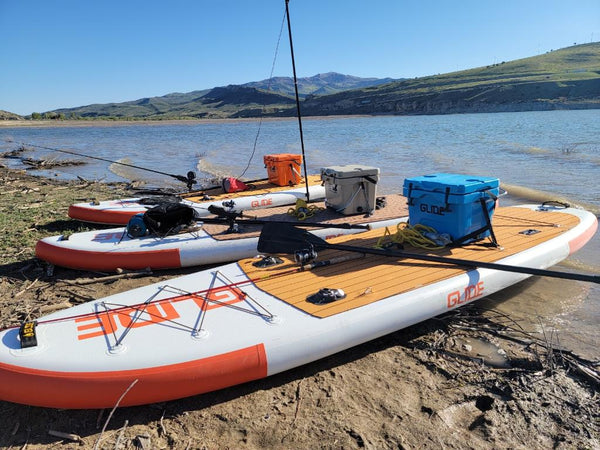
Must-Have SUP Accessories
Navigating the wide array of stand-up paddleboard (SUP) accessories can be overwhelming for both new and seasoned paddlers. Understanding which accessories are essential and which might not be necessary can help you optimize your paddling experience without cluttering your garage with unused gear. Here's a focused breakdown to guide your purchases, distinguishing between must-have items and those that are nice to have but not essential.
Must have stand up paddle board accessories
1. Paddle, Fin, and Manual Pump: These are non-negotiable for inflatable paddleboards. Without them, you're literally not going anywhere. If a used board doesn't include these, factor in the cost of purchasing them separately.

Your paddle board might have permanent side fins installed on it but you still need a main center fin. You might go without it if you're in very shallow water but for a normal day on the water, you need that main fin.
2. SUP Leash: An essential safety item that keeps you tethered to your board if you fall off. It's a must for most water conditions, though caution is advised in rivers due to potential entanglement hazards.
3. Life Jacket (PFD): A crucial safety gear that's often required by law. For those who dislike bulky life jackets, consider an inflatable PFD for comfort without compromising safety.
4. Kayak Seat: Enhances comfort for long-distance paddling, offering a sitting option for when standing becomes tiresome. It's particularly useful for beginners or those using their SUP for fishing or leisurely tours.

5. SUP Board Bags:
Ideal for storage and transportation, especially if the board comes with wheels and backpack straps, making it easier to carry to the water.

Great but Not Essential Accessories
These are some paddle board accessories that I personally love but I could do without if I really needed to. Most of these won't come with your paddle board but you can find them all online at a reasonable price.

1. Electric Pump and Battery:
Saves time and effort in inflating your board but not strictly necessary if you're okay with manual pumps.

Electric pumps typically plug into the 12v adapter on your car but you can purchase a battery pack with a 12v adapter so that you can take your electric pump anywhere.

Overall, if you have the cash to spare, I recommend picking up an electric pump
2. Anchor Pole or Anchor Kit:
Useful for staying in place while fishing, doing yoga, or taking a break on the water, especially in windy conditions or currents.

The nice thing about a SUP cooler is that it is the perfect size to fit on a SUP board. Great for keeping refreshments cold on long paddles or fishing trips, doubling as a seat for added convenience.

4. SUP Fishing Rod Holder:
A niche accessory for paddlers interested in fishing, allowing you to securely place your rod while paddling or waiting for a catch.

5. Paddle Board Strap:
Offers added convenience in transporting your board, especially for longer distances from your vehicle to the water.

6. Dry Bag:
Essential for keeping valuables dry, though makeshift solutions can work in a pinch. A dedicated dry bag, however, offers reliability and peace of mind.

7. Cam straps/river straps
Cam straps are a staple of paddle boarding and paddle sport culture. They're adjustable straps that are great for securing anything that you would ever need to secure and they are a must have if you have a hard board that you plan to transport on your roof rack.
If you are using an inflatable SUP board, however, this is something that is still useful but you can get by without it by using ropes or other straps.
Accessories You Can Probably Do Without
1. Specialty Car Roof SUP Rack: A standard roof rack suffices for most paddlers, including those with multiple hard boards. Inflatable boards don't require roof racks at all, further reducing the necessity of a specialty rack.
2. Paddle Board Cart: Mainly useful for those with hardboards facing a long trek to the water. Many paddlers find that a simple strap or carrying the board is adequate for shorter distances.

Paddle board cart
This is another piece of gear that won't be very useful to the average SUP user. A SUP cart is a small frame with a couple of wheels that you strap on to the back of your SUP so that you can pull it along behind you instead of carrying it. It's only going to be useful for people who are using a hardboard and have to walk it far enough that a simple, cheap strap won't do the job well enough.
This is another one of the SUP accessories that can be easily DIYed as well if you are even a little bit handy. Either way, as far as I am concerned, if the beach is close enough to walk to, you probably won't need a SUP cart. Don't buy it unless you've already tried the alternatives.
Conclusion
When investing in SUP accessories, prioritize those that enhance safety, convenience, and your overall experience on the water. While it's tempting to gear up with every available accessory, focusing on essentials can save you money and storage space, ensuring you have what you need for enjoyable and safe paddleboarding adventures. Remember, the best accessory is the one that meets your specific needs while complementing your paddling lifestyle. Don't get wrapped up in a spending spree when you get a brand new SUP board and consider buying a board that comes with all of the must have accessories like an inflatable paddle board from Glide.
Related Topics
Things to Consider When Buying a SUP
Improving Fitness on Paddle Board
Back to The Future With The O2 Retro


